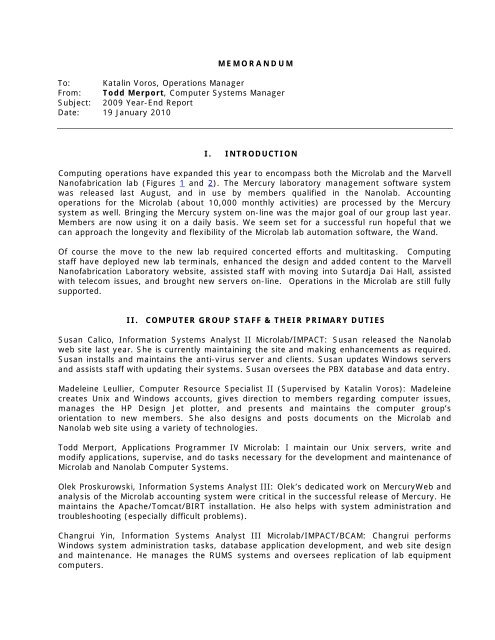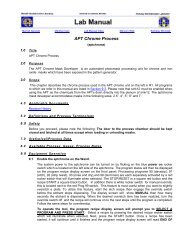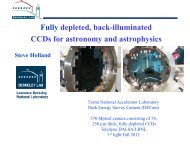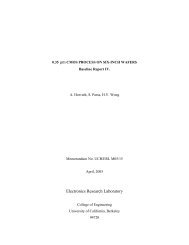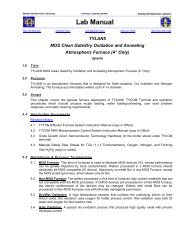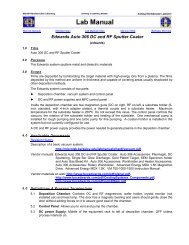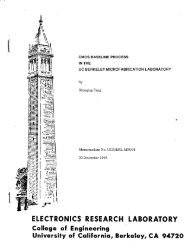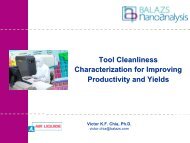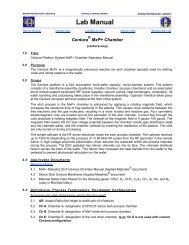You also want an ePaper? Increase the reach of your titles
YUMPU automatically turns print PDFs into web optimized ePapers that Google loves.
MEMORANDUM<br />
To: Katalin Voros, Operations Manager<br />
From: <strong>Todd</strong> <strong>Merport</strong>, Computer Systems Manager<br />
Subject: 2009 Year-End Report<br />
Date: 19 January 2010<br />
I. INTRODUCTION<br />
Computing operations have expanded this year to encompass both the <strong>Microlab</strong> and the Marvell<br />
Nanofabrication lab (Figures 1 and 2). The Mercury laboratory management software system<br />
was released last August, and in use by members qualified in the Nanolab. Accounting<br />
operations for the <strong>Microlab</strong> (about 10,000 monthly activities) are processed by the Mercury<br />
system as well. Bringing the Mercury system on-line was the major goal of our group last year.<br />
Members are now using it on a daily basis. We seem set for a successful run hopeful that we<br />
can approach the longevity and flexibility of the <strong>Microlab</strong> lab automation software, the Wand.<br />
Of course the move to the new lab required concerted efforts and multitasking. Computing<br />
staff have deployed new lab terminals, enhanced the design and added content to the Marvell<br />
Nanofabrication Laboratory website, assisted staff with moving into Sutardja Dai Hall, assisted<br />
with telecom issues, and brought new servers on-line. Operations in the <strong>Microlab</strong> are still fully<br />
supported.<br />
II. COMPUTER GROUP STAFF & THEIR PRIMARY DUTIES<br />
Susan Calico, Information Systems Analyst II <strong>Microlab</strong>/IMPACT: Susan released the Nanolab<br />
web site last year. She is currently maintaining the site and making enhancements as required.<br />
Susan installs and maintains the anti-virus server and clients. Susan updates Windows servers<br />
and assists staff with updating their systems. Susan oversees the PBX database and data entry.<br />
Madeleine Leullier, Computer Resource Specialist II (Supervised by Katalin Voros): Madeleine<br />
creates Unix and Windows accounts, gives direction to members regarding computer issues,<br />
manages the HP Design Jet plotter, and presents and maintains the computer group’s<br />
orientation to new members. She also designs and posts documents on the <strong>Microlab</strong> and<br />
Nanolab web site using a variety of technologies.<br />
<strong>Todd</strong> <strong>Merport</strong>, Applications Programmer IV <strong>Microlab</strong>: I maintain our Unix servers, write and<br />
modify applications, supervise, and do tasks necessary for the development and maintenance of<br />
<strong>Microlab</strong> and Nanolab Computer Systems.<br />
Olek Proskurowski, Information Systems Analyst III: Olek’s dedicated work on MercuryWeb and<br />
analysis of the <strong>Microlab</strong> accounting system were critical in the successful release of Mercury. He<br />
maintains the Apache/Tomcat/BIRT installation. He also helps with system administration and<br />
troubleshooting (especially difficult problems).<br />
Changrui Yin, Information Systems Analyst III <strong>Microlab</strong>/IMPACT/BCAM: Changrui performs<br />
Windows system administration tasks, database application development, and web site design<br />
and maintenance. He manages the RUMS systems and oversees replication of lab equipment<br />
computers.
III. SYSTEM ADMINSTRATION<br />
The <strong>Microlab</strong> and Nanolab use a variety of platforms, operating systems, and tools. Table 1<br />
summarizes hardware (mainly non-equipment systems). Workstations for staff and terminals in<br />
the labs use Windows XP systems. Primary servers run on Solaris platforms with Apache 2.x.<br />
Windows servers are used for terminal, anti-virus, and web/database servers. Generally Solaris<br />
systems are used for key <strong>Microlab</strong> and Nanolab infrastructure services. Distribution of server<br />
tasks across multiple units permits less disruption if a server fails or requires maintenance. It<br />
also keeps systems from unnecessary dependencies or entanglement.<br />
Mike Howard of EECS networking installed network equipment throughout Sutardja Dai Hall and<br />
IDF3 and IDF5 in the Nanolab. He solved many wiring issues with building contractors who<br />
installed CAT5e wiring. These efforts have provided for the Nanolab a solid foundation of 100,<br />
1000Base-T active ports. The computer group participated in finalizing and testing telecom<br />
details and setup servers in the IDF 5 to support interlock control and facilities monitoring<br />
where RUMS2 is fully operational.<br />
A production server for the Mercury system (database, web server, Mercury-Server,<br />
MercuryWeb) was purchased and brought on-line. Olek setup the Apache and Tomcat<br />
installations, compiled the Ingres database from source code on this system, and compiled, set<br />
up other software as needed. I implemented the Mercury-Server, sendmail, mail filtering, and<br />
the firewall.<br />
Changrui installed several workstations for <strong>Microlab</strong> staff. He also brought online several new<br />
terminals in the <strong>Microlab</strong>. He manages various backup systems that have been very successful<br />
when restoration of equipment is necessary (most recently aln) from a corrupted disk or<br />
botched configuration. He has managed our anti-virus systems, lab terminals, and servers very<br />
successfully. The anti-virus system management has been passed down to Susan Calico this<br />
year. He has been very busy doing to sort of unheralded work required to keep staff and<br />
members working with minimal interruption.<br />
IV. SOFTWARE<br />
Development proceeded on many fronts in 2009 starting with the Mercury system, updating the<br />
Wand, and development of the Nanolab website.<br />
Enhancements to the Wand<br />
I set up triggers and tables in the <strong>Microlab</strong> database to track reservation inserts and deletes.<br />
Also, I wrote a program to test who is in the <strong>Microlab</strong>, check idle times, and broadcast global<br />
warning messages if it appears someone is working alone in the lab.<br />
I implemented a test database and program to capture data from the tytalk daemon. Initial<br />
tests show tube data can be put into a variable character field (screen data) and retrieved<br />
properly. Each result is marked by date and tube number. This will be further developed this<br />
year when the tystars are brought on-line in the Nanolab.<br />
RUMS2<br />
Changrui set up a new installation of RUMS. It uses Labview, C#, IIS, and SQL Server.<br />
Changrui analyzed the current system and made coding changes to the various technologies in<br />
RUMS2 to create a new instance successfully.<br />
- 2 -
Machine Shop Jobs System<br />
Changrui added forms and coding to permit separate reports and queries for Nanolab related<br />
jobs.<br />
New Development -- MERCURY<br />
Mercury has several facets: the Mercury client (released as Mercury-1.0), the Mercury server,<br />
and MercuryWeb (see Figure 3). Aside from writing the java code in the netbeans environment,<br />
Olek created a mapping and synchronizing system to pull data from the <strong>Microlab</strong> activity table<br />
into the Mercury database and process the data with the Mercury accounting system such that<br />
one unified accounting system is used for the <strong>Microlab</strong> and Nanolab. Extensive ongoing testing<br />
comparing data from both systems has shown excellent results (within pennies). It is all the<br />
more remarkable since the Wand accounting system made its debut in 1986. Olek also<br />
implemented changes to the Mercury database for reservation rules (for the first time there is a<br />
form and definitions). Olek refined the Mercury client and server to improve client-server<br />
communication speed by a factor of two.<br />
I updated the Mercury server’s EquipmentManager and EControl classes to handle Hydra and<br />
ControlByWeb communications. These classes get properties set for equipment that will be<br />
enabled/disabled or require specialized resource queries from RUMS2. Figure 4 shows how data<br />
is entered for a Hydra connection.<br />
Various programs required to run daily are in production: reservation reminders, calendars, and<br />
mail alias generation. I added some additional functions to Mercury client. Login and logout<br />
dialogs now warn labusers if no one is logged in or if they are the second to last member.<br />
Additional messages for login and logout prompts can be programmed by inserting fields into<br />
the messages table.<br />
nanolab.berkeley.edu<br />
Susan Calico designed and coded the new Marvell Nanolab web site. Susan quickly integrated<br />
the web pages into our Apache web server infrastructure and worked with staff to determine<br />
specifications and technical requirements. She wrote PHP programs for dynamic parts of the<br />
web site. She also developed a document conversion process so that laboratory manuals can be<br />
converted to PDF format. This simplifies the on-line posting, mailing, and printing of the lab<br />
manuals.<br />
Equipment Control - Hydra<br />
The equipment control system for the Marvell lab (designated as Hydra) has been deployed and<br />
operational. Aside from commands directly piped from the Mercury client, I wrote additional<br />
software to test channels, enable or disable sequences of channels, program front panel<br />
operations for manual override, and a database resynchronization function. The Hydra diagram<br />
shows a custom front panel sequence execution “ALL_ENABLE” that can be used when<br />
computer systems require bypassing. Jay Morford made valuable refinements to the Hydra<br />
relay box that permit the box to work with both AC and DC interlocks separately or at the same<br />
time. Michael Martin integrated the switch control unit in IDF 5 with the Nanolab’s CAT3 wiring<br />
scheme. Olek’s form on MercuryWeb for equipment properties allows simple entry of Hydra<br />
channel information. The example shows for a configuration for crestec that is wired through<br />
Slot 4, channel 7 on Hydra (Figures 4 and 5).<br />
- 3 -
V. FUTURE PLANS<br />
I think process monitoring and equipment communication (tystar, gcapc) tasks will parallel<br />
equipment moves or bringing new equipment on-line in the Nanolab. We are also queuing up<br />
requests for new features on MercuryWeb. Some fixes and re-arrangement of actions are<br />
required on Mercury client in addition to performance improvement (Olek made significant<br />
progress on that front already). Work will be needed on RUMS to upgrade to a supported OS.<br />
Some tasks such as new user creation and purchase orders now done on the Wand will move to<br />
MercuryWeb. This will likely require modifications and fixes to MercuryWeb as these new<br />
processes go live for the first time. Remote sites in Cory Hall will be hooked into Mercury<br />
instead of the Wand (novellus, jeol, autoprobe).<br />
VI. SUMMARY<br />
Major new systems were brought online in 2009 for the Nanolab while <strong>Microlab</strong> operational<br />
support continued uninterrupted. 2010 promises to be equally dynamic as new tools come<br />
online in the Nanolab and staff fully occupy Sutardja Dai Hall.<br />
VII. COMMENTS<br />
OLEK PROSKUROWSKI<br />
The first half of the year I spent preparing Mercury to be released for general use.<br />
Set up new server to host Mercury system, this included compiling Ingres database on the<br />
new server.<br />
Thoroughly tested all MercuryWeb functionality.<br />
Incorporated new features requested by <strong>Microlab</strong> staff; reservation rules and BFS upload<br />
being the most important.<br />
Migrated Wand data to Mercury database.<br />
Created a program to synchronize Wand and Mercury databases which greatly simplified<br />
keeping both systems in consistent state.<br />
The second half of the year I spent mainly on supporting the new Mercury system.<br />
Fixed discovered bugs.<br />
Added many new features and enhancements. Speeding up Mercury client startup, adding<br />
visibility column to resources table and adding properties to locations and utilities being<br />
the most significant.<br />
Ran daily synchronization of Wand and Mercury databases.<br />
Resolved any discrepancies in monthly reports between Wand and Mercury.<br />
Assisted in creating monthly BFS upload.<br />
Trained <strong>Microlab</strong> members on new Mercury system.<br />
Throughout the year, I also:<br />
Installed necessary security patches for apache web servers.<br />
Assisted <strong>Todd</strong> with system administration.<br />
- 4 -
CHANGRUI YIN<br />
Windows Servers Administration<br />
I installed system security and recommended patches. Built the new Symantec Antivirus<br />
10.1.800 server. Restored the compromised machine shop server in a few hours by using the<br />
Acronis restore software and UC backup. Built Rums2 and resolved the web graphs and email<br />
problems. Tightened security on web servers. Performed backups (cape, rums, rums2, mshopserver,<br />
microlab2, microlab3, <strong>Microlab</strong>5) and documentation.<br />
Staff & Lab Computers Support<br />
Build/rebuilt multiple staff computers. Setup staff windows accounts. Upgraded the Symantec<br />
Antivirus Client to the version 10.1.800 on 49 Windows computers and configured their firewall.<br />
Restored lab equipment computer, aln. Moved and setup staff computers in SDH. Repaired<br />
software/hardware problems on staff and lab computers.<br />
Printer support<br />
I installed several new printers and scanners. Moved printers from Cory to SDH. Fixed printing<br />
problems on staff computers and print servers. Assisted users with plotter problems.<br />
Additionally, I assisted staff with Wand issues and various Unix problems.<br />
Future projects<br />
My future projects include building a new CAPE terminal server, upgrading RUMS and RUMS2 to<br />
Windows 2003 from Windows 2000, moving computers and printers to SDH Hall, monitoring<br />
patch status, backing up systems, and remotely installing or updating software.<br />
Marvell NanoLab Website<br />
SUSAN CALICO<br />
Migration of shared information from the <strong>Microlab</strong> website to the Marvell NanoLab website and<br />
new information for the NanoLab have created a fully functioning NanoLab site. A News page<br />
announces progress in the NanoLab tool moves and preserves a thumbnail history of the move.<br />
http://nanolab.berkeley.edu/<br />
http://nanolab.berkeley.edu/news.html<br />
A new Lab Manual, containing updated pages for equipment moved, will be standardized with a<br />
NanoLab template. Equipment manuals for the NanoLab tools and utilities have been posted.<br />
http://nanolab.berkeley.edu/labmanual/labmantoc.html<br />
Membership information shared by <strong>Microlab</strong> and NanoLab was updated and formatted for the<br />
NanoLab website, then linked also to the <strong>Microlab</strong> website. On the back end, single-source rate<br />
files automatically update rate information on multiple web pages.<br />
http://nanolab.berkeley.edu/membership/membershipaf.shtml<br />
http://nanolab.berkeley.edu/membership/membershipac.shtml<br />
Phone lists for emergency contacts, lab phones, staff members, and 911 phone list were<br />
standardized and consolidated into a source spreadsheet.<br />
- 5 -
As members move from Cory Hall to Sutardja Dai Hall, internal information on the new<br />
computer and office environment (where to get keys or find equipment manufacturer’s<br />
manuals) was posted on the staff portion of the site.<br />
https://microlab.berkeley.edu/MNL/staffportal.html<br />
Print stylesheets print web-page content with lab contact information at the top, but strip out<br />
the web menus and banners. Processes and sources for website pages are documented,<br />
including menus, rotating sponsor display, tool move status display, and single-sourcing of<br />
data.<br />
Anti-Virus Protection<br />
Monitored eight servers and 40 workstation clients for anti-virus scanning and updating, and<br />
virus activity. Worked with staff to leave workstations on overnight (when scanning and<br />
updating are scheduled), achieving 97% current scanning and updates.<br />
Detected several virus infections, determined the ongoing source of one serious infection that<br />
had repeatedly compromised several workstations, requiring them to be completely rebuilt. A<br />
server was also compromised in one attack.<br />
Security Patches and Updates<br />
Reviewed announced product security updates and sent weekly notification and instructions to<br />
staff. Performed updates for four staff whose administrative computer rights had been revoked.<br />
Tutored with staff members who were not familiar with the updating process.<br />
PBX/Phone System<br />
Managed phone station assignment, setting up phone assignments for new staff members,<br />
clearing voicemail, and resetting passwords. Reset phone system display time. Determined and<br />
troubleshot trunk connection failure.<br />
- 6 -
VIII. FIGURES & TABLES<br />
Function Platform Operating System Count Responsible<br />
Desktop X86 Dell (Mostly) Windows XP 45 scalico, changrui<br />
Web, DB, Mail, Apps UltraSparc Solaris 10 4 merport, olek<br />
Web, DB, Equipment Comm. X86 Solaris 10 3 merport , olek<br />
Web, LabView X86 Dell Windows 2000 Server 2 changrui, merport<br />
Terminal Services Xeon Dell Windows 2003 Server 2 changrui, scalico<br />
FileSystem, Web, Database,<br />
Anti-Virus<br />
X86 Dell Windows 2003 Server 3 changrui, scalico<br />
Cad Workstation, EGLAS UltraSparc Solaris 9,10 3 merport, olek<br />
Cad Workstation X86 Dell Windows XP 1 changrui, scalico<br />
Thin /Thick Clients Neoware/DELL Windows CE/XP 34 changrui, scalico<br />
Interlock Controllers X86/Control By Web LINUX 3 merport, olek<br />
Interlock Controllers Agilent 34980A LINUX 1 merport , olek<br />
Networked Printers HP, Brother 11 changrui, scalico<br />
Networked Equipment Various Various 10 changrui, merport<br />
TOTAL: 122<br />
Table 1 - Hardware Summary<br />
Function Primary Technologies Operating System Responsible<br />
MercuryClient,, MercuryServer Ingres,Java Solaris 10 merport, olek<br />
MercuryWeb Ingres, Java, Netbeans,Apache Solaris 10 olek, merport<br />
Wand C,Ingres Solaris 10 merport,olek<br />
Wand on the Web C, Ingres, Perl Solaris 10 merport,olek<br />
RUMS, RUMS2. Labview, SQL Server Win2k changrui,merport<br />
Mail Filter (microdomo) Sendmail, perl Solaris 10 merport, olek<br />
PUMPS SQL Server, IIS, .NET, Access Windows 2003 Server changrui, merport<br />
Machine Shop Jobs SQL Server, IIS, .NET Windows 2003 Server changrui, merport<br />
GASES SQL Server, IIS, .NET,Access Solaris 9,10 changrui, merport<br />
Mask Request MySQL, Apache, PHP Solaris10 merport , olek,<br />
CAD (gds2tap) C, csh Solaris 10 merport, olek<br />
Interlock Utilities (Hydra) Perl, SCPI Solaris 10 merport, olek<br />
Nanolab Web Site CSS Solaris 10 scalico , leullier<br />
<strong>Microlab</strong> WebSite CSS Solaris 10 leullier, scalico<br />
Table 2 - In-House Software<br />
- 7 -
print420<br />
HPLaserJet<br />
2100<br />
gold<br />
Unix/Cad<br />
Solaris 10<br />
187 Cory<br />
(Machine Shop)<br />
XP Workstations (6)<br />
188<br />
Cory<br />
Voice<br />
Synthesizer<br />
wis3<br />
Equipment<br />
controller<br />
(wis)<br />
RH Linux<br />
oxygen<br />
Ledit<br />
winxp<br />
Computer Systems Infrastructure Cory Hall<br />
plotter<br />
HPDesignJet T1100PS<br />
Thin Clients (1)<br />
Lobby<br />
mshop-server<br />
win2003<br />
Lobby PC (6)<br />
winxp<br />
Additional Client<br />
Systems in Cory<br />
Hall for<br />
Staff in 188M<br />
CMP in 190<br />
Novellus in 144A<br />
EE143 in 218<br />
silicon<br />
<strong>Microlab</strong><br />
CA-1<br />
microlab2 <strong>Microlab</strong>3<br />
File and WebTerminal<br />
Server<br />
win2003 win2003<br />
silicon2<br />
FileServer<br />
Database<br />
Solaris 10<br />
UPS<br />
mercury<br />
File &<br />
Database Server<br />
microlab5<br />
Solaris 10<br />
Terminal Server<br />
win2003<br />
Network switch for<br />
Cape in Y1<br />
490 Cory<br />
(Device<br />
Characterization Lab)<br />
zirconium<br />
eglas<br />
Solaris 9<br />
silicon3<br />
Mail<br />
Nis Master<br />
tellurium<br />
Solaris 10<br />
Cape<br />
win2k3<br />
autoprobe<br />
Autoprobe Station 2<br />
metrix software<br />
XP<br />
yttrium<br />
Anti-Virus<br />
Server<br />
Mercury2<br />
Mercury DB<br />
MercuryWeb<br />
Figure 1 - <strong>Microlab</strong> Infrastructure<br />
- 8 -<br />
rums<br />
FacilityMonitoring<br />
win2k<br />
wis<br />
Equipment<br />
Controller<br />
(wis)<br />
RH Linux<br />
CA-2<br />
Boron<br />
Cad<br />
Solaris 10<br />
406 Cory<br />
(Office)<br />
XP Workstations (21)<br />
Print406<br />
HPLaserJet<br />
4350TN<br />
UPS<br />
key<br />
Cape Thin<br />
Clients (10)<br />
microcam<br />
Axis 207<br />
Network<br />
Camera<br />
Cape Access PC (5)<br />
550 Cory<br />
Acronis True<br />
Image Server<br />
hostname<br />
[function]<br />
OS<br />
UNIX/Linux<br />
Phase Out/<br />
Upgrade Soon<br />
Microsoft<br />
Phase Out Now<br />
165 Cory T.M. 08/24/02<br />
Rev 12/19/2008<br />
Rev. 5/19/2009<br />
Rev. 1/18/2010
Print580sd<br />
Brother<br />
HL-5470 DW<br />
Crestec Server<br />
win2k3<br />
Crestec Server<br />
win2k3<br />
Crestec Client<br />
winxp<br />
Staff Workstations<br />
WinXp (3)<br />
520<br />
Computer Systems Infrastructure Sutardja Dai Hall<br />
580<br />
Gowning<br />
Print520sd<br />
HP LaserJet<br />
4100dtn<br />
Terminals (6)<br />
winxp<br />
Nanolab<br />
hydraserver<br />
Equipment<br />
Controller<br />
(hydra)<br />
Solaris 10<br />
Chlorine<br />
Serial Comm.<br />
Server r<br />
(tystar)<br />
Solaris 10<br />
386<br />
Staff Workstations<br />
WinXp (3)<br />
IDF5<br />
Print242<br />
Brother Laser Printer<br />
243<br />
rums2<br />
FacilityMonitoring<br />
win2k<br />
Figure 2 - Nanolab Infrastructure<br />
- 9 -<br />
key<br />
UPS<br />
hostname<br />
[function]<br />
OS<br />
UNIX/Linux<br />
Phase Out/<br />
Upgrade Soon<br />
Microsoft<br />
Phase Out Now<br />
T.M. 1/19/2010<br />
Terminals (10)<br />
Winxp<br />
(10 additional terminals<br />
To be installed)
Figure 3 - Simplified Mercury Architecture<br />
Figure 4 - Equipment Properties Editing on MercuryWeb<br />
- 10 -
Figure 5 - Hydra Equipment Control<br />
- 11 -


